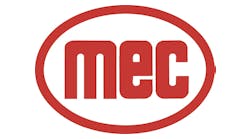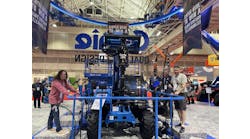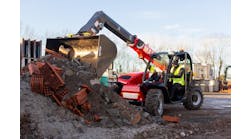The compact equipment market is one of the construction equipment industry’s hottest. Eleven compact equipment experts — representing nine manufacturers and one industry publication — recently gave RER their thoughts on market growth, technology trends and high fuel prices. This is the second in our three-part series of market insights published in RER Reports. The panel includes:
- Randy Vargason , Mustang general manager
- Doug Dahlgren, Allmand Bros. product manager
- Kent Pellegrini, Caterpillar Inc., skid-steer loader/multi-terrain loader industry manager
- Greg Lawrence, The Toro Company marketing product manager, Dingo compact utility loaders
- Jim Hughes and Dave Wolf, Case Construction Equipment brand marketing managers
- Bill Gearhart, Yanmar Construction Equipment assistant marketing and product manager
- Gregg Zupancic, John Deere Worldwide Construction & Forestry product marketing manager, skid steers and compact track loaders
- Mike Ross, Takeuchi Mfg. national product and training manager
- Lowell Stout, Terex senior product manager
- Keith Gribbins, Compact Equipment magazine managing editor
Vargason: Leveling off of skid-steer loader sales will remain as the popularity of other compact units continues to soar. Track loader, telehandler and compact excavator sales should continue on their upward trajectories.
Dahlgren: Since the construction market as a whole is strong and growing, the rental and purchase of compact equipment will continue to grow as well.
Lawrence: Compact utility loaders are new to the market compared to some other equipment in rental yards. Rental yards and contractors are identifying new ways to use these machines every day, and the equipment also is replacing application-specific machines because of its versatility, making it easier to rent. We think this trend will continue, and are hopeful we’ll see double-digit growth for this category in the future.
Hughes/Wolf: It’s hard to put the growth into numbers because one of the products, compact track loaders, is not officially tracked by AEM. However, forecast and economic indicators show steady growth into next year.
Gearhart: I would estimate that the markets we participate in have grown around 20 percent, and I would anticipate a similar growth rate for 2006.
Zupancic: The most noticeable drivers of the compact equipment business are closely tied to housing and construction markets and thus the rental and landscape industries have been two of the main economic highlights for the business. These segments offer the largest growth potential for the compact equipment market segment in 2006 and beyond. As interest rates stay at reasonable levels, the building and landscape segments of the business will stay strong and drive future compact equipment sales. The skid steer and compact track loader markets were strong once again in 2005. The 2006 outlook continues to be positive. Skid-steer sales are projected to be up slightly and the compact track loader market is expected to see significant growth due to more competitors entering the business and additional familiarity with performance attributes.
The attachment business is the major purchase driver of the compact equipment business. The whole key to the compact business is attachment versatility. For example, if a customer buys a hydraulic hammer and scrap grapple to do demolition work, when that business gets slow, the customer has the opportunity to purchase a completely different attachment at a reasonably low acquisition cost and get into an entirely different line of work, such as recycling, building, underground or landscaping.
Ross: We estimate the market grew 25 to 30 percent in 2005. This year we expect the market to grow about 20 to 25 percent.
Are there any major trends or changes in technology that you're seeing?
Vargason: Joystick-style controls and systems that require less effort from the operator are hot items now. The transition from hand-foot to these joystick systems follows an overall trend toward operator comfort and efficiency. Rental inventory purchasers want machine components that differentiate their fleet from the competition. And while components like joystick controls or other creature comforts like suspension seats or air-conditioning may not demand a higher rate, they will inspire customer loyalty by giving the operator a much more enjoyable experience.
GPS tracking systems are also in demand, particularly for rental fleets. Preventing theft is the main objective for these systems. Monitoring systems and automatic shut-downs are also popular, as owners are attracted to equipment that helps protect itself from damage or catastrophic failure.
Dahlgren: A lot of new technologies are available, but unfortunately, they are not cost effective. Basically, the expense of some of the new technologies doesn’t make it justifiable to implement at this time. What has been very effective is the work we’ve done improving our pins, bushings, seals and other components. These may seem like small refinements, but added up all together, the improvements will make the machine perform at its peak for a longer time.
Lawrence: Store owners seeing success with their rental fleet will continue to replace less versatile, single-purpose machines with a broader array of loader attachment offerings to capture additional ROI. We know of one rental store owner who makes the Dingo TX 413 machine, attachments and a trailer available in a single package that benefits his customers while boosting his bottom line. His standard machine rental price includes the Dingo compact utility loader unit and bucket. However, when a customer picks up the machine, it’s loaded on the trailer with not only the bucket, but all of the unit’s other attachments, including an auger power head and two-foot trencher. A specially printed tag has been placed on each attachment’s latch pin. If a customer desires to use an attachment other than the bucket they’ve rented, they simply break off the tag and are charged for the use of the additional attachment when they return the unit. Having all the attachments available to use often inspires users to not only complete the project for which the unit was rented, but also take on additional tasks that may not have been considered initially.
Hughes/Wolf: There is a movement toward making the machines more efficient and the operators more comfortable because a comfortable operator is a productive operator and that means more money in the rental company’s pocket. Things like A/C and heat, suspension seat, ride control (which acts like a shock absorber by cushioning the loader arms from the jolts of rough terrain, eliminating the front-to-rear rocking motion that equipment experiences under load), hydraulic couplers, auxiliary hydraulics, switches on the control levers and accessory outlets (for cell phones and CD players, for example) are a few ergonomic improvements Case offers that are designed specifically for operator comfort. Not only that, but Case has improved operator visibility to make the machines easier, safer and more productive to operate.
Gearhart: We have sold compact excavators in many applications that in the past would have been done with a conventional backhoe. We have also seen increased interest in compact tractor loader backhoes like our recently introduced CBL40. It is designed as a small, but heavy-duty piece of construction equipment rather than designed as an agricultural tractor with loader and backhoe attachments added.
Zupancic: We see customers requesting more creature comfort features inside the operator station of the equipment we manufacture. John Deere provides standard and optional equipment, such as a suspension seat, cushioned boom cylinders and a 12-volt receptacle for charging cell phones, using laptops or air pumps. In addition, a two-speed transmission, cab enclosure, heater/defroster, air conditioning, powered in-cab Quik-Tatch and high-flow hydraulics continue to be available as productivity enhancement options.
An optional four-season cab enclosure, which features air-conditioning and a heater/defroster to allow the operator to control temperature and humidity, has been enhanced to provide more than 30 percent more airflow. All air-conditioning components are easily accessed for maintenance or service.
Ross: More and more customers are requesting pilot-operated joystick controls. Foot pedals for operating the boom and bucket functions are becoming a thing of the past.
Stout: Hydrostatic drive systems are becoming more popular in compact machines because it allows more flexibility in the design of the machine. Placement of major components within the design of the machine can be maximized. For example, Terex compact wheel loaders have the engines placed transverse at the rear of the machine so that the weight of the engine adds to the stability of the machine.
Gribbins: Two of the major trends we see are attachments and tracks.
Attachments and machines called “tool carriers” are very much on the rise. What manufacturers and customers want are what are called “utility machines.” These are pieces of equipment that can do a myriad of tasks on a jobsite — dig holes, grade, load, seed, haul — through the use of attachments or implements. Skid steers started this trend, but in the 90s and 00s, tool carrier machines exploded, including compact utility loaders and compact excavators. The idea is having one machine that can do just about anything on the jobsite. The attachment industry has also seen enormous growth, as well as consolidation (just look at Paladin). Making machines as versatile as possible has been one of the biggest trends.
Tracks have been huge — especially compact track loaders. Rubber track loaders, all-terrain loaders or compact track loaders have been the biggest growth market in compact machinery. These are skid-steer type machines that use the same attachment plate as skid steers, but with a dedicated track undercarriage instead of wheels. These machines have been around for years (since the late 80s), but in the last four years the market has had explosive growth. Since 2000, Caterpillar, Bobcat, Case, New Holland, Komatsu, and John Deere have all entered the compact track loader market. And pioneers ASV and Takeuchi have only expanded their product lines.
What do you predict for the next year in the market in terms of trends, growth, and technology?
Vargason: Skilled operators are becoming harder to find, so anything that will attract and retain these workers will be popular. In addition to the increase in attention paid to comfort and monitoring systems, equipment buyers will look for components that keep a machine running as long, and as efficiently, as possible. Rental fleet buyers will add creature comforts to fill the demand of long-term rentals. Attachments will continue to be popular in the rental industry as rental houses aim to increase the versatility and seasonality of their compact units.
Lawrence: These machines are becoming more and more of a staple item in rental stores. Store owners are asking themselves, “Why would I buy a dedicated machine and limit my options when, for similar dollars, I could invest in a multi-use platform?”
Hughes/Wolf: You are going to see more trends that support operator comfort and productivity. Features you see in larger equipment like laser/GPS systems, dig guidance systems, cab convenience features are going to make their way into the compact equipment markets. Emission regulations will require new engine technology to be implemented to meet certifications.
Gearhart: I expect the compact equipment market to continue its expansion. Advancing technology is a big part of making compact equipment highly productive yet able to operate in constricted spaces. One example of innovative technology is the hydro-mechanical transmission in our CBL40. Our hydro-mechanical transmission is a blend of hydrostatic and mechanical transmission technology that takes advantage of the best of both systems while minimizing their disadvantages.
Zupancic: Customers are asking for things like fuel efficiency, lower noise and better overall operational experience in the compact equipment they purchase. This is why, starting in 2007, the John Deere skid steers and compact track loader lines will come standard with the all-new CoolPower fan technology that provides better fuel efficiency, more efficient cooling and less jobsite noise by rotating only as fast as necessary to keep the machine productive and cool. Deere is working on many more items of this nature to help provide needed solutions for purchasers of compact equipment.
Ross: Better creature comforts, suspension seats and air conditioning.
Stout: Operator comfort continues to be an important feature on all construction machines. However, it is more difficult to achieve on compact machines because of size constraints. The operator space is one of the largest items to incorporate into the machine’s design and, therefore, you are going to see more effort put into reducing the size of other components to allow more operator space. Terex, for example, continues to incorporate full-width cabs on mini-excavators in an effort to give the operator more comfort.
Gribbins: I see continual growth for the compact equipment market. We’ll see more consolidation in the attachment industry. I expect bigger growth numbers for compact track loaders and compact utility loaders. I see skid steer and mini excavator sales staying steady (with not too much growth). We’ll see Tier 3 engine regulations beginning to come into play, with engines in general being the focus for many manufacturers (especially with growing fuel costs). I think we’ll see more growth in the private user markets, as big boxes like Lowe’s and Home Depot begin to sell and rent compact machinery.





